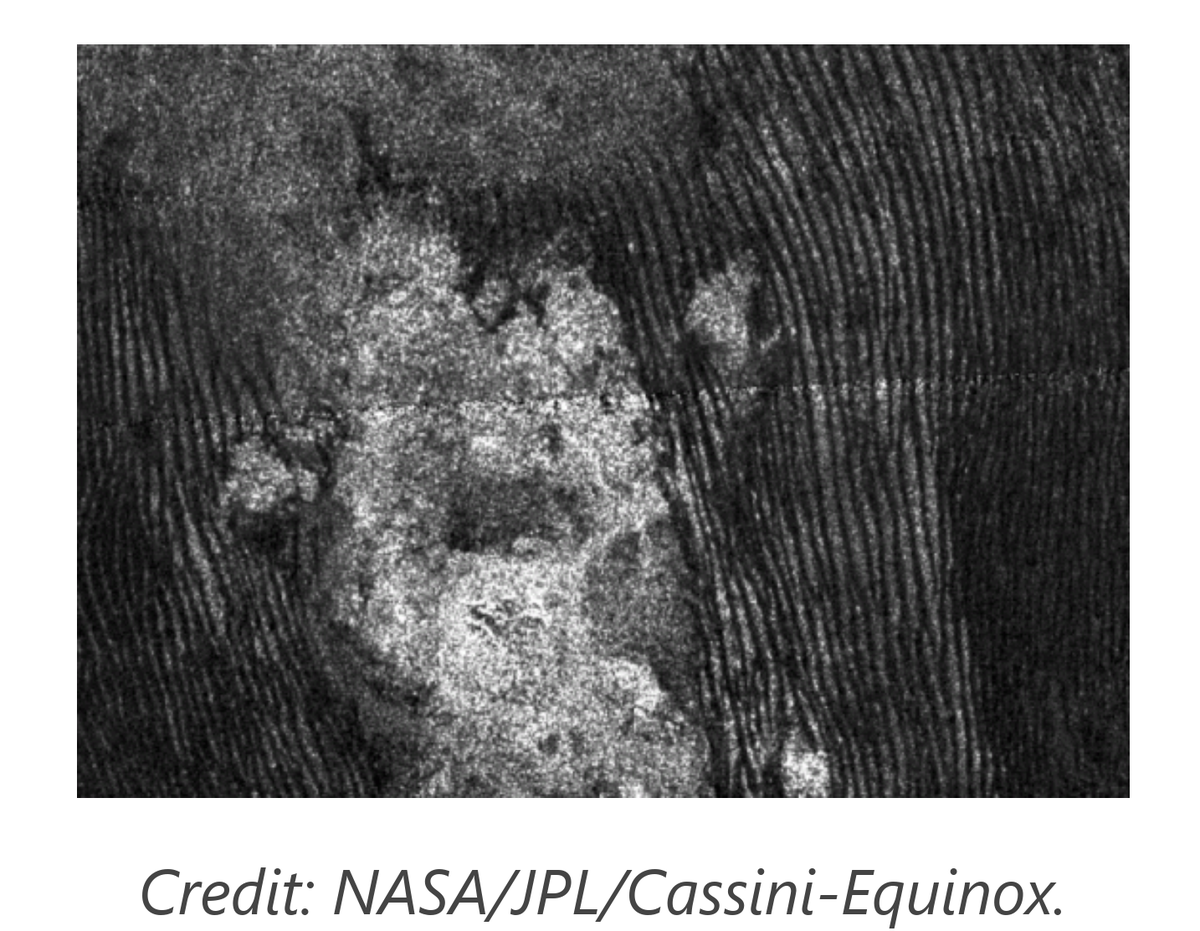ザ・サンダーボルツ勝手連 [Titan’s Frozen Desert タイタンの凍った砂漠]
[Titan’s Frozen Desert タイタンの凍った砂漠]
Stephen Smith September 30, 2013Picture of the Day

Thousands of dune-like features on Titan.
タイタンの何千もの砂丘のような特徴。
――――――――
Oct 01, 2013
「炭化水素で濡れた」環境で砂丘はどのように形成されますか?
砂丘の形成は、太陽系の4つの場所、地球、火星、金星、タイタンで発見されています。
ある例では、平均気温は摂氏15度から17度の範囲で、液体の水が豊富な環境です。
別のケースでは、平均気温は摂氏マイナス50度で、液体の水はまったくありません、一方、灼熱の溶岩惑星の平均摂氏460度は、3番目のシナリオを構成します。
タイタンの表面温度は平均マイナス180℃です。
そこは、非常に寒いので、水が存在する場合、それは岩のようになり、極寒の世界の化学に寄与しません。
環境の違いにもかかわらず、高さ数百メートルの規則的な山に積み上げられた微粒子のパターンを作成できる力は何ですか?
タイタンでは、いわゆる「砂丘」が非常に大きく、数千キロ離れたカッシーニオービターから見ることができます。
〈https://photojournal.jpl.nasa.gov/jpeg/PIA11802.jpg〉
それらはまた、火星の「ヤルダン」と呼ばれるクレーターの上や周りを通過する、明確に定義された、ほぼ固形に見える波です。
〈http://themis-data.asu.edu/planetview/inst/themis/V12350012#P=V12350012&T=2〉
砂丘は、時速8kmしか吹かないタイタンの卓越風(常風)のパターンに従っているように見えます、しかし、それらはまた、それらが従来の意味での風によって生成されないことを意味するかもしれない幾つかの異常な特徴を持っています。
〈https://photojournal.jpl.nasa.gov/jpeg/PIA07009.jpg〉
砂丘の多くは指紋パターンのように見えます
—それらには、ナミビアの海岸に沿って見られる砂丘のフィールドとほぼ同じように見える、垂直に配置された他の波紋が交差する渦巻きとアーチがあります。
〈https://photojournal.jpl.nasa.gov/jpeg/PIA09181.jpg〉
〈http://www.wohba.com/blogimages/titan2enhanced1105.jpg〉
〈https://www.lpl.arizona.edu/~rlorenz/ESC_large_STS107_STS107-E-5380.JPG〉
地球上では、砂丘は最も乾燥した場所でのみ見られます。
砂丘が積み重なって風景を横切って移動するには、砂粒とほこりが互いに自由にスライドできる必要があります。
砂を動かすには通常強風が必要です。
オーストラリアのシンプソン砂漠などの一部の場所では、砂丘が化石化して動かなくなっています、それらは数千平方キロメートルをカバーしていますが。
〈http://www.thunderbolts.info/tpod/2009/arch09/090306megaripples.htm〉
そこに堆積させた砂を、如何なるものでもそれを再び動かすことができなかったので、それらは固まり、植物が根を下ろし、そしてガリーが形成されました。
ミッションチームのメンバーは、タイタンが炭化水素で「濡れている」と推測しています。
実際、ホイヘンスプローブがタイタンに着陸したとき、それはやや砕けやすい表面の中にわずかに沈みました。
〈https://apod.nasa.gov/apod/image/0501/titancolor_huygensP7_c120.jpg〉
NASAの惑星科学者は、それを「湿った雪のように」、「緩い粘土」、またはもっと重要なことに「乾いた砂」と表現しました。
プローブの周囲に検出可能なメタンがありましたが、すぐに消散しました
—おそらく着陸船から発せられる熱のためです。
このような深い冷たさでは、角氷の温度は熱く沸騰します。
重力が低いにもかかわらず、タイタンが濡れていると、風(実際にはそよ風にすぎません)は、長い砂丘に物質を蓄積することができません。
湿気があると、ほこりがべたつくようになり、大きな粒がスラッシュ(半溶けの雪泥)に混入します。
ホイヘンス着陸船によって記録されたそのような最小の風速で、その表面に液体エタンとメタンの「湖」があるというNASAからの主張にもかかわらず、タイタンが乾燥しているのは当然のことです。
〈http://photojournal.jpl.nasa.gov/archive/PIA09177.mov〉
もしタイタンが乾いていて、そして、折り畳まれた縁と広くて平らな底(多くの場合、複数の層または同心円状の盆地がある)、平行な割れ目、金星のものと同様の大きなドーム、および地形に切り込まれたリッチェンバーグ(リヒテンベルク)図形(カッシーニチームによって川の水路と呼ばれる)を備えたクレーター、がある場合、それならば、火星を検討することで、土星の惑星サイズの月衛星に何が起こったのかについてのより良い説明が見つかるかもしれません。
〈https://photojournal.jpl.nasa.gov/jpeg/PIA07365.jpg〉
〈https://photojournal.jpl.nasa.gov/jpeg/PIA08737.jpg〉
〈https://photojournal.jpl.nasa.gov/jpeg/PIA12036.jpg〉
火星では、砂丘は電気アークに伴うと識別されています。
〈http://www.badastronomy.com/pix/bablog/2006/mars_dunes_sm.jpg〉
〈http://www.thunderbolts.info/tpod/2007/arch07/070514russellcrater.htm〉
掘削された物質が地層から排出されると、それらは、それを電流の流れの経路に沿って上向きに吹き飛ばし、そこでそれは落ちて、いわゆる「風の筋」を形成しました。
火星では塵は帯電している可能性が高いため、粒子は極性に応じて互いに引き付けられたり反発したりする可能性があります。
したがって、それらは、鉄のやすり粉が棒磁石の磁場と整列するのとほぼ同じ方法で自己整列します。
それがタイタンの砂丘構造の背後にあるメカニズムでもある可能性があります。
タイタンの赤道緯度には、ベレットと呼ばれる素晴らしい「砂の海」があります。
地球、金星、火星のように、放電活動によって破壊され、その後、ミシガン州よりも大きな砂の塊にイオン的に堆積した岩層の断片を表す場合、それはおそらく砂丘や細かい塵の筋の源です。
金星でも縞や砂丘が発見されています。
〈https://history.nasa.gov/JPL-93-24/p67.htm〉
〈https://nssdc.gsfc.nasa.gov/imgcat/hires/mgn_p38810.gif〉
ほとんどの場合、それらはクレーターと曲がりくねったリルに関連付けられています;
両方の地層の端には、暗い色または明るい色の粒子がちりばめられていることがよくあります。
タイタンの砂丘は非常に似ているため、ローバータイプの着陸船が訪れると、「ブルーベリー」やその他の球形の小石や石が見つかる可能性があります。
乾燥していて寒く、曲がりくねったリル、巨大なクレーター、混沌とした地形、高さ500メートルの堆積した塵の千キロメートルの尾根で覆われています、タイタンは、最近の太陽の家族の間での壊滅的な荒廃のもう1つの例です。
スティーブン・スミス
――――――――
Oct 01, 2013
How can dunes form in an environment “wet with hydrocarbons”?
「炭化水素で濡れた」環境で砂丘はどのように形成されますか?
Dune formations have been found in four locations in the Solar System: Earth, Mars, Venus, and Titan.
砂丘の形成は、太陽系の4つの場所、地球、火星、金星、タイタンで発見されています。
In one instance the average temperature ranges from between 15 and 17 Celsius, with an environment rich in liquid water.
ある例では、平均気温は摂氏15度から17度の範囲で、液体の水が豊富な環境です。
In another case, the average temperature is minus 50 Celsius with no liquid water at all, while an average of 460 Celsius on a scalded lava planet makes up the third scenario.
別のケースでは、平均気温は摂氏マイナス50度で、液体の水はまったくありません、一方、灼熱の溶岩惑星の平均摂氏460度は、3番目のシナリオを構成します。
The surface temperature on Titan averages minus 180 Celsius.
タイタンの表面温度は平均マイナス180℃です。
It is so cold that if water were present it would be more like rock and would not contribute to any chemistry on the frigid world.
そこは、非常に寒いので、水が存在する場合、それは岩のようになり、極寒の世界の化学に寄与しません。
What force can create patterns of fine particles heaped into regular piles, some hundreds of meters high, despite the disparity in environments?
環境の違いにもかかわらず、高さ数百メートルの規則的な山に積み上げられた微粒子のパターンを作成できる力は何ですか?
On Titan, the so-called “dunes” are quite large, being visible from the Cassini orbiter thousands of kilometers away.
タイタンでは、いわゆる「砂丘」が非常に大きく、数千キロ離れたカッシーニオービターから見ることができます。
〈https://photojournal.jpl.nasa.gov/jpeg/PIA11802.jpg〉
They are also well-defined, almost solid-looking waves that pass over craters and around what are called on Mars “yardangs.”
それらはまた、火星の「ヤルダン」と呼ばれるクレーターの上や周りを通過する、明確に定義された、ほぼ固形に見える波です。
〈http://themis-data.asu.edu/planetview/inst/themis/V12350012#P=V12350012&T=2〉
The dunes appear to follow the prevailing wind patterns on Titan that blow a mere 8 kilometers per hour, but they also have some unusual characteristics that may mean they are not generated by wind in the conventional sense.
砂丘は、時速8kmしか吹かないタイタンの卓越風(常風)のパターンに従っているように見えます、しかし、それらはまた、それらが従来の意味での風によって生成されないことを意味するかもしれない幾つかの異常な特徴を持っています。
〈https://photojournal.jpl.nasa.gov/jpeg/PIA07009.jpg〉
Many of the dunes look like fingerprint patterns
—they have whorls and arches that are crisscrossed by other ripples in a perpendicular arrangement, looking almost exactly like the dune fields found along the coast of Namibia.
砂丘の多くは指紋パターンのように見えます
—それらには、ナミビアの海岸に沿って見られる砂丘のフィールドとほぼ同じように見える、垂直に配置された他の波紋が交差する渦巻きとアーチがあります。
〈https://photojournal.jpl.nasa.gov/jpeg/PIA09181.jpg〉
〈http://www.wohba.com/blogimages/titan2enhanced1105.jpg〉
〈https://www.lpl.arizona.edu/~rlorenz/ESC_large_STS107_STS107-E-5380.JPG〉
On Earth, dunes are found only in the driest places.
地球上では、砂丘は最も乾燥した場所でのみ見られます。
The sand grains and dust must be able to slide freely over one another for the dunes to pile up and move across the landscape.
砂丘が積み重なって風景を横切って移動するには、砂粒とほこりが互いに自由にスライドできる必要があります。
Strong winds are usually required to move the sand.
砂を動かすには通常強風が必要です。
In some places, such as Australia’s Simpson Desert, sand dunes have become fossilized and immobile, although they cover thousands of square kilometers.
オーストラリアのシンプソン砂漠などの一部の場所では、砂丘が化石化して動かなくなっています、それらは数千平方キロメートルをカバーしていますが。
〈http://www.thunderbolts.info/tpod/2009/arch09/090306megaripples.htm〉
Whatever deposited the sand there was unable to move it again, so they have crusted over, plants have taken root, and gullies have formed.
そこに堆積させた砂を、如何なるものでもそれを再び動かすことができなかったので、それらは固まり、植物が根を下ろし、そしてガリーが形成されました。
It has been speculated by mission team members that Titan is “wet” with hydrocarbons.
ミッションチームのメンバーは、タイタンが炭化水素で「濡れている」と推測しています。
In fact, when the Huygens probe landed on Titan, it sank slightly into a somewhat friable surface.
実際、ホイヘンスプローブがタイタンに着陸したとき、それはやや砕けやすい表面の中にわずかに沈みました。
〈https://apod.nasa.gov/apod/image/0501/titancolor_huygensP7_c120.jpg〉
NASA planetary scientists described it as “like wet snow,” or “loose clay,” or more significantly, “dry sand.”
NASAの惑星科学者は、それを「湿った雪のように」、「緩い粘土」、またはもっと重要なことに「乾いた砂」と表現しました。
There was detectable methane in the area surrounding the probe, but it quickly dissipated
—presumably because of the heat emanating from the lander.
プローブの周囲に検出可能なメタンがありましたが、すぐに消散しました
—おそらく着陸船から発せられる熱のためです。
In such deep cold, the temperature of an ice cube would be boiling hot.
このような深い冷たさでは、角氷の温度は熱く沸騰します。
If Titan were wet, despite its low gravity, the winds (really no more than gentle breezes) would not be able to accumulate material into long dunes.
重力が低いにもかかわらず、タイタンが濡れていると、風(実際にはそよ風にすぎません)は、長い砂丘に物質を蓄積することができません。
Any moisture would cause the dust to become sticky and any larger grains would be mired in the slush.
湿気があると、ほこりがべたつくようになり、大きな粒がスラッシュ(半溶けの雪泥)に混入します。
With such minimal wind speeds recorded by the Huygens lander, it stands to reason that Titan is dry, despite claims from NASA that there are “lakes” of liquid ethane and methane on its surface.
ホイヘンス着陸船によって記録されたそのような最小の風速で、その表面に液体エタンとメタンの「湖」があるというNASAからの主張にもかかわらず、タイタンが乾燥しているのは当然のことです。
〈http://photojournal.jpl.nasa.gov/archive/PIA09177.mov〉
So, if Titan is dry and there are craters with folded rims and wide, flat bottoms (often with more than one tier or concentric basin), parallel fractures, large domes similar to those on Venus, and Lichtenberg figures (called river channels by the Cassini team) incised into the terrain, then perhaps a better explanation for what happened to Saturn’s planet-sized moon might be found by considering Mars.
もしタイタンが乾いていて、そして、折り畳まれた縁と広くて平らな底(多くの場合、複数の層または同心円状の盆地がある)、平行な割れ目、金星のものと同様の大きなドーム、および地形に切り込まれたリッチェンバーグ(リヒテンベルク)図形(カッシーニチームによって川の水路と呼ばれる)を備えたクレーター、がある場合、それならば、火星を検討することで、土星の惑星サイズの月衛星に何が起こったのかについてのより良い説明が見つかるかもしれません。
〈https://photojournal.jpl.nasa.gov/jpeg/PIA07365.jpg〉
〈https://photojournal.jpl.nasa.gov/jpeg/PIA08737.jpg〉
〈https://photojournal.jpl.nasa.gov/jpeg/PIA12036.jpg〉
On Mars the dunes have been identified with electric arcs.
火星では、砂丘は電気アークに伴うと識別されています。
〈http://www.badastronomy.com/pix/bablog/2006/mars_dunes_sm.jpg〉
〈http://www.thunderbolts.info/tpod/2007/arch07/070514russellcrater.htm〉
When the discharges excavated material from the strata, they blew it upward along the path of current flow where it then fell away, forming what are called “wind streaks.”
掘削された物質が地層から排出されると、それらは、それを電流の流れの経路に沿って上向きに吹き飛ばし、そこでそれは落ちて、いわゆる「風の筋」を形成しました。
Dust is most likely charged on Mars, so particles can be attracted or repelled from one another, depending on their polarity.
火星では塵は帯電している可能性が高いため、粒子は極性に応じて互いに引き付けられたり反発したりする可能性があります。
Therefore, they will align themselves in much the same way that iron filings will align themselves with the magnetic field of a bar magnet.
したがって、それらは、鉄のやすり粉が棒磁石の磁場と整列するのとほぼ同じ方法で自己整列します。
It is possible that that is the mechanism behind the dune structures on Titan, as well.
それがタイタンの砂丘構造の背後にあるメカニズムでもある可能性があります。
In the equatorial latitudes of Titan is a great “sand sea” called Belet.
タイタンの赤道緯度には、ベレットと呼ばれる素晴らしい「砂の海」があります。
If, like Earth, Venus, and Mars it represents the fragments of rock strata that were destroyed by electric discharge activity and then ionically deposited in masses of sand larger than the State of Michigan, it is probably the source for the dunes and streaks of fine dust.
地球、金星、火星のように、放電活動によって破壊され、その後、ミシガン州よりも大きな砂の塊にイオン的に堆積した岩層の断片を表す場合、それはおそらく砂丘や細かい塵の筋の源です。
Streaks and dunes have also been discovered on Venus.
金星でも縞や砂丘が発見されています。
〈https://history.nasa.gov/JPL-93-24/p67.htm〉
〈https://nssdc.gsfc.nasa.gov/imgcat/hires/mgn_p38810.gif〉
Most of the time, they are associated with craters and sinuous rilles;
the edges of both formations are often dusted with dark or light colored grains.
ほとんどの場合、それらはクレーターと曲がりくねったリルに関連付けられています;
両方の地層の端には、暗い色または明るい色の粒子がちりばめられていることがよくあります。
Titan’s dunes are so similar that “blueberries,” or other spherical pebbles and stones, may be found if a rover-type lander ever pays a visit there.
タイタンの砂丘は非常に似ているため、ローバータイプの着陸船が訪れると、「ブルーベリー」やその他の球形の小石や石が見つかる可能性があります。
Dry, cold, covered with sinuous rilles, gigantic craters, chaotic topography, and thousand-kilometer ridges of piled-up dust 500 meters high, Titan is one more example of catastrophic devastation among the Sun’s family in the recent past.
乾燥していて寒く、曲がりくねったリル、巨大なクレーター、混沌とした地形、高さ500メートルの堆積した塵の千キロメートルの尾根で覆われています、タイタンは、最近の太陽の家族の間での壊滅的な荒廃のもう1つの例です。
Stephen Smith
スティーブン・スミス